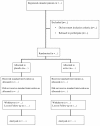Fructose-1, 6-diphosphate (FDP) as a novel antidote for yellow oleander-induced cardiac toxicity: a randomized controlled double blind study
- PMID: 20587052
- PMCID: PMC2912827
- DOI: 10.1186/1471-227X-10-15
Fructose-1, 6-diphosphate (FDP) as a novel antidote for yellow oleander-induced cardiac toxicity: a randomized controlled double blind study
Abstract
Background: Cardiac toxicity due to ingestion of oleander plant seeds in Sri Lanka and some other South Asian countries is very common. At present symptomatic oleander seed poisoning carries a mortality of 10% in Sri Lanka and treatment of yellow oleander poisoning is limited to gastric decontamination and atropine administration. The only proven effective antidote is digoxin antibodies but these are not available for routine use because of the high cost. The main objective of this study is to investigate the effectiveness of a new and inexpensive antidote for patients with life threatening arrhythmias due oleander poisoning.
Method/design: We set up a randomised double blind clinical trial to assess the effectiveness of Fructose 1, 6 diphosphate (FDP) in acute yellow oleander poisoning patients admitted to the adult medical wards of a tertiary hospital in Sri Lanka. Patients will be initially resuscitated following the national guidelines and eligible patients will be randomised to receive either FDP or an equal amount of normal saline. The primary outcome measure for this study is the sustained reversion to sinus rhythm with a heart rate greater than 50/min within 2 hours of completion of FDP/placebo bolus. Secondary outcomes include death, reversal of hyperkalaemia on the 6, 12, 18 and 24 hour samples and maintenance of sinus rhythm on the holter monitor. Analysis will be on intention-to-treat.
Discussion: This trial will provide information on the effectiveness of FDP in yellow oleander poisoning. If FDP is effective in cardiac glycoside toxicity, it would provide substantial benefit to the patients in rural Asia. The drug is inexpensive and thus could be made available at primary care hospitals if proven to be effective.
Trial registration: Current Controlled trial ISRCTN71018309.
Similar articles
-
Management of yellow oleander poisoning.Clin Toxicol (Phila). 2009 Mar;47(3):206-12. doi: 10.1080/15563650902824001. Clin Toxicol (Phila). 2009. PMID: 19306191 Review.
-
Cardiac arrhythmias, electrolyte abnormalities and serum cardiac glycoside concentrations in yellow oleander (Cascabela thevetia) poisoning - a prospective study.Clin Toxicol (Phila). 2019 Feb;57(2):104-111. doi: 10.1080/15563650.2018.1499930. Epub 2018 Aug 3. Clin Toxicol (Phila). 2019. PMID: 30073854
-
Fructose-1,6-diphosphate in the treatment of oleander toxicity in dogs.Vet Hum Toxicol. 1999 Feb;41(1):9-15. Vet Hum Toxicol. 1999. PMID: 9949476
-
Yellow oleander poisoning in eastern province: an analysis of admission and outcome.Indian J Med Sci. 2013 Jul-Aug;67(7-8):178-83. Indian J Med Sci. 2013. PMID: 24469562
-
Successful treatment of oleander intoxication (cardiac glycosides) with digoxin-specific Fab antibody fragments in a 7-year-old child: case report and review of literature.Z Kardiol. 2005 Dec;94(12):817-23. doi: 10.1007/s00392-005-0293-3. Z Kardiol. 2005. PMID: 16382383 Review.
Cited by
-
Increased acetylcholine esterase activity produced by the administration of an aqueous extract of the seed kernel of Thevetia peruviana and its role on acute and subchronic intoxication in mice.Pharmacogn Mag. 2014 Jan;10(Suppl 1):S171-5. doi: 10.4103/0973-1296.127370. Pharmacogn Mag. 2014. PMID: 24914300 Free PMC article.
-
Human Deaths Related to Oleander Poisoning: A Review of the Literature.Toxins (Basel). 2025 Mar 1;17(3):115. doi: 10.3390/toxins17030115. Toxins (Basel). 2025. PMID: 40137888 Free PMC article. Review.
-
Protection of rat cardiac myocytes by fructose-1,6-bisphosphate and 2,3-butanedione.PLoS One. 2012;7(4):e35023. doi: 10.1371/journal.pone.0035023. Epub 2012 Apr 27. PLoS One. 2012. PMID: 22558110 Free PMC article.
-
Applied clinical pharmacology and public health in rural Asia--preventing deaths from organophosphorus pesticide and yellow oleander poisoning.Br J Clin Pharmacol. 2013 May;75(5):1175-88. doi: 10.1111/j.1365-2125.2012.04449.x. Br J Clin Pharmacol. 2013. PMID: 22943579 Free PMC article. Review.
-
Phytochemical and GC-MS analysis of Thevetia peruviana fruit methanol extract as an anti-rodenticide potential against balb C rats.Heliyon. 2024 Apr 2;10(7):e29012. doi: 10.1016/j.heliyon.2024.e29012. eCollection 2024 Apr 15. Heliyon. 2024. PMID: 38601616 Free PMC article.
References
-
- Eddleston M, Ariaratnam CA, Meyer WP, Perera G, Kularatne AM, Attapattu S, Sheriff MH, Warrell DA. Epidemic of self-poisoning with seeds of the yellow oleander tree (Thevetia peruviana) in northern Sri Lanka. Trop Med Int Health. 1999;4(4):266–273. doi: 10.1046/j.1365-3156.1999.00397.x. - DOI - PubMed
-
- Bose TK, Basu RK, Biswas B, De JN, Majumdar BC, Datta S. Cardiovascular effects of yellow oleander ingestion. J Indian Med Assoc. 1999;97(10):407–410. - PubMed
-
- Hardin CD, Lazzarino G, Tavazzi B, Di Pierro D, Roberts TM, Giardina B, Rovetto MJ. Myocardial metabolism of exogenous FDP is consistent with transport by a dicarboxylate transporter. Am J Physiol Heart Circ Physiol. 2001;281(6):H2654–2660. - PubMed
Publication types
MeSH terms
Substances
Associated data
Grants and funding
LinkOut - more resources
Full Text Sources
Medical


